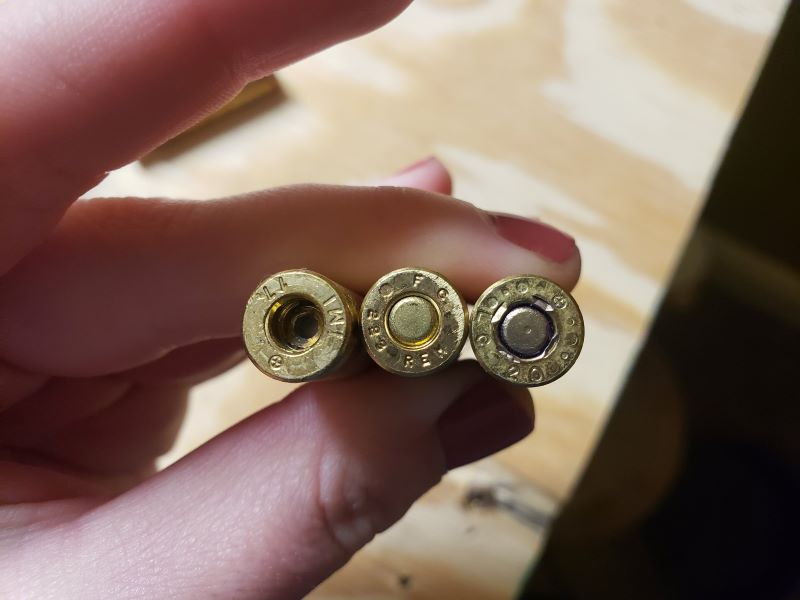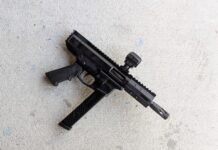
Definitions
Before we go too deep into this, let’s go over some quick definitions when it comes to seating primers.
Primer: The entire primer assembly.
Primer Pocket: This is the part of the case that the primer seats into. Sometimes these pockets can have crimpings which keep the primer in after they were seated. Crimpings can cause issues when seating the next primer as the crimp may not be removed enough to create a wide enough hole for the next primer to fully seat.
Primer Cup: The small metal cup that the propellant and anvil are placed into.
Anvil: The anvil is the part of the primer that you will see when the primer cup is flipped upside down and ready to be seated. The anvil almost looks like a cross. This presses into the primer mixture which then detonates the primer.
Seating a Primer: Using a tool to place the primer into the primer pocket of the casing with pressure.
Primer Tray or Primer Tube: This is how the primers are fed towards the shellholder to be seated. Some tools use a tray in which you can see every individual primer side by side and it feeds down at an angle. Some use a tube and feeds primers directly down with each primer directly on top of one another.
Flash hole: The smaller hole above the primer pocket in which the detonation flows through to detonate the powder.

What is the risk when it comes to seating primers?
Seating primers can actually be pretty dangerous. Ever remember seeing the “wear eye protection” warnings on priming tools? That has merit. A personal friend has actually had an entire tray of primers go off in his hand causing damage to his hand. If he was looking straight at the case when the primer was being seated even his face may be damaged. The story is as follows..
“Imagine two primers facing each other. The top primer gets shoved into the primer pocket misaligned. Bottom primer keeps getting pressed together with more force. The primer anvils get crushed together and almost touch. Then suddenly the primers are ripped apart and a spark or some force detonates the two primers and then chain reaction detonates the other 130 primers”. -Anonymous
What causes this to happen?
There are a couple things that cause catrostophic issues like primers blowing up.
- Your primer pocket can be either gunked up, or the crimp isn’t removed enough to allow a primer to seat. Thus instead of seating the primer, your actually putting pressure on the primer as it is trying to seat but has no where to go.
- Primers are not laying flat when ready to be seated, causing the tool to seat a primer on it’s side. Now imagine that and another primer feeding in behind it pushing on the anvil. That is exactly what happened to the person earlier mentioned.
- A primer get’s half seated and stuck inside of the shellholder. When this happens it is hard to remove the case from the tool because that primer is now catching the case and the shell holder together. Most will try to rip the case out of the tool and off of the shell holder without taking the time to figure out what is going on first or remove the case properly.

How do we mitigate this risk?
- Pay attention. If using a hand primer ensure that each primer coming out of the tool is flat and not upside down/anvil facing up. This is especially important for handheld primers as these are easy to tip.
- If using a priming tube make sure primers are stacked/seated properly.
- If a primer feels half seated and the case is stuck inside the shell holder don’t panic, but don’t just rip it out. Simply observe what is going on. You may have to remove the entire case holder from the tool gently. You could have a primer pocket issue. The big thing here is to ensure that another primer has not fed down under that half seated primer. If you give the half seated primer another press, you may actually be pressing two primers together. If you see no issues with the primer pocket go back and gently try to reseat that primer without any other primers loaded into the tray.
- Be gentle and follow instructions when seating. Many primer seating tools only need a small amount of pressure but want you to ensure that you are pressing all the way through. Going fast and short will often cause issues. Two hands should never be used on a handprimer.
- Don’t look down into the case as you’re seating the primer. There is still a flash hole in that case, if the primer ignites that goes up the case and into your face, or ignites all of the primers in the tray..
- Don’t have anything flammable nearby. If one goes off, it’s best to try to make this an isolated incident.
Primer Tool Type and Example
Handheld Priming Tool
This is simply a primer tool that you hold in your hand and squeeze. They are often the most inexpensive. The risk associated with these is that due to holding it in your hand, the tool can be shaken or tilted more allowing for primers to be seated back to back or flipped. Squeezes can also be inconsistent and primers may be half loaded more often. Remember, never use two hands to squeeze a handheld primer. Too much force is not a good thing.

Hornady Handheld Priming Tool
Price: $59.94 on Amazon
Bench Mounted Hand Priming Tool
Tube Fed
Primal Rights CPS Press with Large & Small Primer System
Price: $675.00 on Primal Rights
Tray Fed
Price: $44.98 on Midway Usa
Press Priming
With a lot of presses that you may use to seat bullets or resize brass there is also an option to attach an assembly to seat primers. This type of assembly will usually be proprietary to the type of press you are using.



